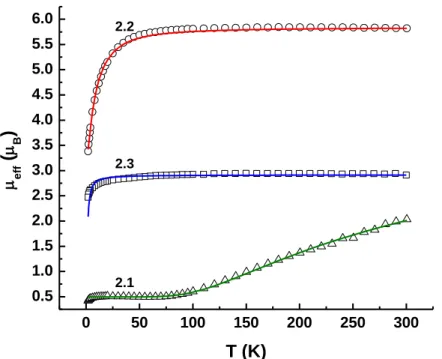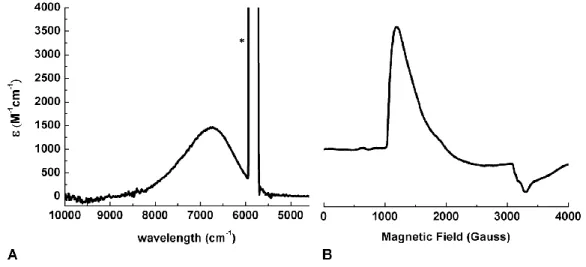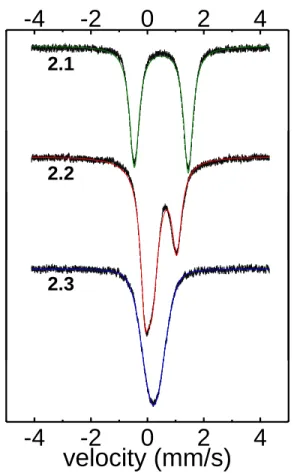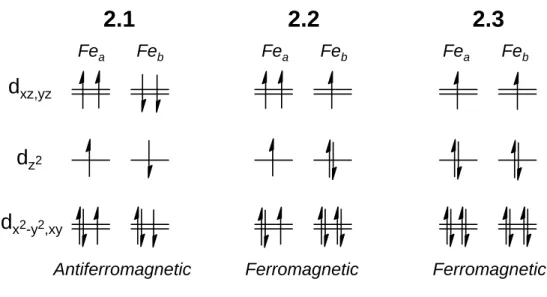I shared a glove compartment with Caroline Saouma in my early days in the lab, and I have her to thank for getting me started in the lab. Sid Creutz has had to sit in the same cubicle with me for a number of years.
Introduction
- Opening Remarks
- Nitrogen Fixation
- Unusually Low Valent Fe-S-Fe Complexes
- Conversion of FeNH 2 to FeN 2 with Release of NH 3
- Catalytic Conversion of N 2 to NH 3 by an Fe Model Complex
- The Effect of Ligand and Reaction Conditions on Fe Mediated N 2 Fixation
- Spectroscopic Characterization of the Putative Catalytic Intermediate [(TPB)Fe≡N-
All the work discussed in this thesis involves the study of complexes either indirectly or directly relevant to the Fe-mediated reduction of N2 to NH3. Overall, the exciting discovery of N2 reduction by [(TPB)Fe(N2)]- motivated further investigations of the catalytic system.

Unusually Low Valent Fe-S-Fe Complexes
Introduction
The Fe-S-Fe unit is common to a multitude of metalloenzymes that mediate metabolic transformations central to life. In this context, Holland and co-workers recently reported {[HC(CMeN[2,6- . diisopropylphenyl])2]Fe}2{μ-S} and the first total Fe(I) sulfide {[HC(CMeN [2 ,6- diisopropylphenyl])2]Fe}2{μ-S}2- and the interactions of the former with nitrogen substrates.6 The Peters laboratory was also interested in studying the unusually low-valent Fe-X- Fe bonds related to the reduction of N2, with examples where the bridging X unit is imide (NH2-) or nitride (N3-).7 Here, this narrative is extended by reporting a series of Fe-S-Fe complexes in the formal Fe(II)/Fe(II) oxidation states, Fe(II)/Fe(I) and Fe(I)/Fe(I).
Results and Discussion
- Low-Valent Fe-S-Fe Complexes
- Reactivity with Small Molecules
If both Fe centers were high spin, as in complex 2.1, a spin-only moment of 6.2 μB can be expected for two weakly interacting Fe centers. Furthermore, although a value for J is obtained in the fit for the moment of 2.2, it should be emphasized that the lack of a significant slope for this complex precludes the accurate determination of J, the data simply requiring a large positive value of J .

Conclusion
Due to the similarity of the ligand set of complex 2.5 with hydrogenase enzymes and the hydrogenase function of nitrogenase in the absence of N2,. The beginnings of the electrocatalytic peak appear near the pair assigned as Fe(II)Fe(II)/Fe(II)Fe(I), indicating that these oxidation states may be involved in the catalytic cycle.
Experimental Section
- General Considerations
- Electrochemical Measurements
- EPR Measurements
- Magnetic Measurements
- Mössbauer Spectroscopy
- X-Ray Crystallography
- Synthesis
It is worth noting that in the structure of 2.1 additional electron density was found in the central core of the molecule. The solution was allowed to stir at RT for 10 min, during which time the color of the solution darkened to black. The solution was allowed to stir for 20 minutes during which time the color of the solution changed from dark brown to deep red-orange.
Conversion of FeNH 2 to FeN 2 with Release of NH 3
Introduction
The complexity of proposed mechanisms for N2 fixation by Fe motivates efforts to synthesize and study intermediates along these pathways, and considerable efforts have been made to characterize many of the different species that may be involved in a catalytic cycle.1, 2 The tris-phosphine frameworks used by the Peters laboratory were particularly useful in this context, stabilizing a wide variety of nitrogen ligands on Fe centers supported by both the (PhBP3) and (SiP3) ligand scaffolds.3 ,4 Despite the isolation of many examples of Fe complexes with. Despite the success of the (TPB) ligand scaffold for the stabilization of substituted imides and the functionalization of N2,7 little work has been done to install functionalities containing N-H bonds. In this context, the synthesis of terminal (TPB)Fe complexes of N2H4, NH3 and NH2- is described.
Results and Discussion
- Formation of a Cationic Fe(I) Synthon
- Conversion of FeNH 2 to FeN 2 with release of NH 3
When considering the (Fe-B)7 subunit bond of 3.2 to estimate the most appropriate oxidation state and valence assignment, two limiting scenarios are presented: Fe(III)/B(I) and Fe(I)/ B. (III). Regardless of the nature of the Fe-B interaction, the ability of 3.2 to bind neutral L-type donors at its vacant apical site was investigated to investigate the utility of this. Finally, the Fe-B distances at 3.3 and 3.4 from 2.392(2) Å and 2.433(3) Å respectively likely indicate a minimal interaction between Fe and B and suggest that a formal oxidation state of Fe(I) is more suitable in these complexes.
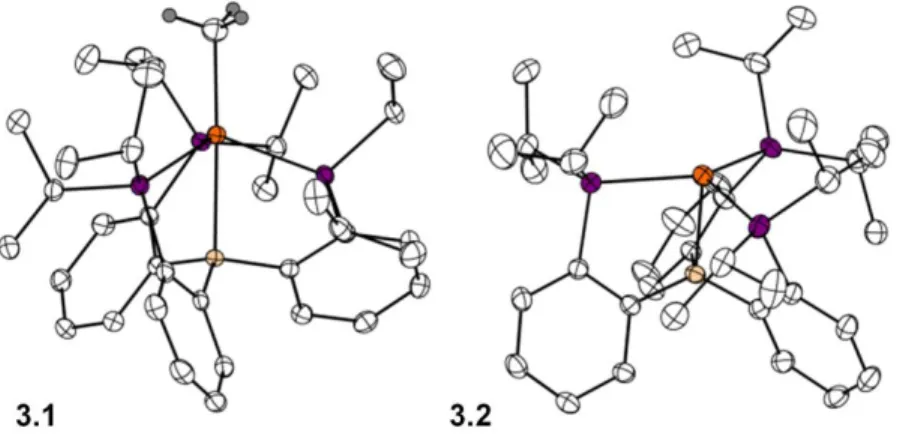
Conclusion
Subsequent exposure of 3.4 to one equivalent of KC8 under a N2 atmosphere liberates NH3 to form the (TPB)FeN2 complex in similarly high yield. Furthermore, these processes represent the final steps of these mechanisms for the regeneration of the FeN2 species and re-entry into the catalytic cycle. Finally, protonation of 3,5 results in the formation of 3,4, which can then be reduced to (TPB)Fe(N2).
Experimental Section
- General Considerations
- EPR Spectroscopy
- X-Ray Crystallography
- Magnetic Measurements
- Computational Methods
- Synthesis
Similarly cooled Et2O (2 mL) was added to the mixture and the color of the solution brightened rapidly. After this time, the solution was filtered and the volatiles removed to give (TPB)Fe(N2) as a brown solid. Product identity was determined via 1H NMR chemical shifts which were identical to previously reported values for (TPB)Fe(N2).
Introduction
The Fe-mediated NH3 formation from N2 is much slower than in the Mo systems. Although significant amounts of NH3 can be generated by the protonation of Fe nitride species6, FeN2 complexes typically yield only small amounts (~10 mol%) of NH3 derived from N2.7 Recently, Holland and co-workers reported an Fe complex than N2 can split into two nitride units that can then be exposed to acid or hydrogen, forming nearly stoichiometric NH3.8 Furthermore, Nishibayashi and co-workers demonstrated the catalytic formation of N(TMS)3 from N2, Na, and TMSCl in the presence of simple Fe catalysts .9 Despite these advances, the development of a molecular system is in favor. While previous attempts with the (SiP3) ligand scaffold yielded only moderate amounts of N2H4,12 the species synthesized in Chapter 3 and the previously reported silylation chemistry prompted further investigation of the (TPB)Fe scaffold in the context of NH3 formation. .13,14 This chapter therefore discusses initial protonation studies of [(TPB)Fe(N2)][Na(12-crown-4)2] that yielded the previously reported complex 3.4.
Results and Discussion
- Initial Protonation Studies
- Catalytic N 2 Reduction to NH 3
- Catalyst Speciation
In addition, the speciation of the Fe-containing complex after catalysis is studied, indicating possible degradation pathways. Second, the observation of 3.4 and 3.2 and other presumably molecular species at the end of the reaction suggests that a molecular process is responsible for the formation of NH3 in this transformation. Reversing the order of reagent addition, with the reductant added first followed by the acid, resulted in an improved yield of 4.8 NH3 equivalents per Fe center.
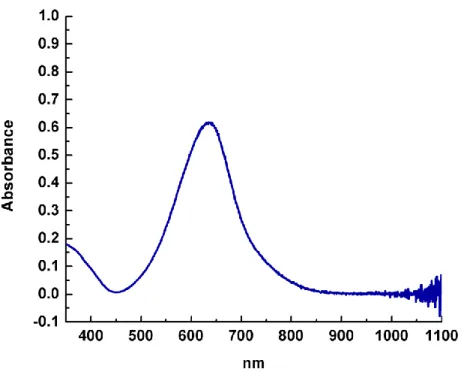
Conclusion
In addition to the termination processes, it was of great interest to determine whether N2H4 was involved in the catalytic cycle, since any presence of N2H4 would imply the involvement of an "alternating" type mechanism. A UV-visible spectroscopic assay similar to the indophenol method for quantification of NH3 was used to detect the presence of N2H4 in the reaction mixtures.19 No N2H4 was detected from any catalytic mixture. Due to the lack of synthetic Fe species that can form significant amounts of NH3 from N2, Mo complexes have received much attention as the potential binding site for N2 in the FeMoco active site of nitrogenase.20 The results reported here indicate the first time that a molecular species of Fe can also catalyze nitrogen fixation with protons and electrons in yields comparable to Mo systems.
Experimental Section
- General Considerations
- Standard Catalytic Protocol
- Ammonia Quantification
- Synthesis of (TPB)FeCl
- Catalytic Protocols
- Other Reaction Protocols
The procedure was identical to that of the standard catalytic protocol with the changes noted. The procedure was identical to that of the standard catalytic protocol with the changes noted. Any residue of the acid was washed with pre-cooled Et2O (0.5 mL) and transferred to the stirred solution.
The Effect of Ligand and Reaction Conditions on Fe Mediated N 2
Results and Discussion
- Ligand and Complex Synthesis
- Structural Characterization
- Comparison of Pre-Catalysts
- Comparison of Catalytic Conditions
Interestingly, in the tetraphosphine complex 5.6, there is in principle the possibility of a hemi-labile interaction with the apical P atom of the ligand scaffold. The low NH3 yields for this system, compared to the other data in Table 5.2, suggest that if any flexibility of the Fe-P bond exists, it does not allow for catalysis in this system. The use of HBArF4 · 2 Et2O was chosen in the standard catalytic runs due to the high acidity and poor coordination ability of the BArF4 counterion.
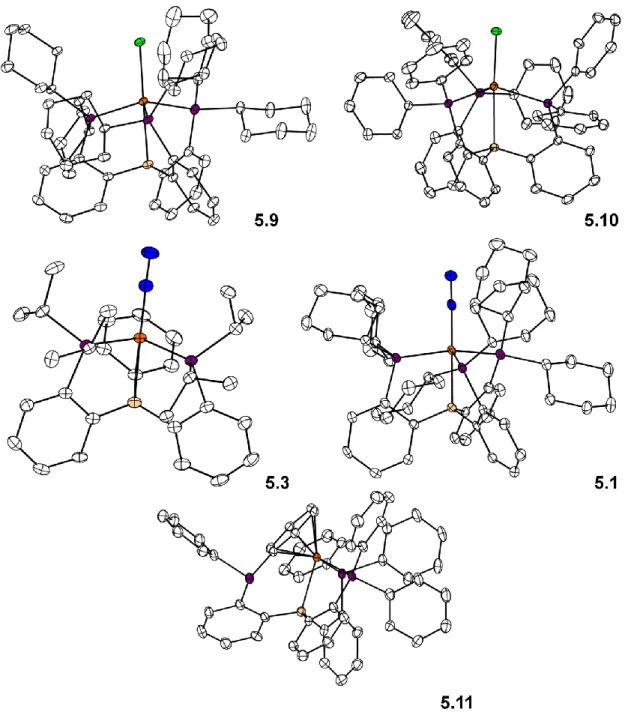
Conclusions
While all the conditions examined showed a decrease in catalytic activity compared to the original results by 4.1, several variations of the reaction conditions preserved the catalytic activity, suggesting some functions required for catalysis. It was also shown that catalysis is still viable with Na/Hg as the reducing agent, suggesting that a graphite adsorbed complex is not essential for the catalytic reaction. Finally, the catalysis must be carried out at low temperature and appears to be active even at temperatures as low as -110 °C, suggesting unusually high activity for this system.
Experimental Section
- General Considerations
- Synthesis
- Catalytic Protocols
The resulting mixture was stirred vigorously for 1 hour, during which time the color of the solution changed from dark brown to deep red. This solution was then filtered through a glass fiber filter paper directly into the catalytic mixture, which turned red upon addition of the reducing agent before gradually fading to yellow. The solution remained heterogeneous and no noticeable color change was observed during the course of the reaction.
Spectroscopic Characterization of the Putative Catalytic Intermediate
Introduction
Previous synthetic work on Mo outlined a "distal" mechanism, in which protons are sequentially added to one nitrogen atom along with electrons to release NH3 and form a metal nitride which is then protonated and reduced to release NH3.2. Alternatively, some of the spectroscopic and enzymatic studies on nitrogenase that implicated Fe as the binding site of N2 also supported another "alternating" mechanism in which protons are alternately added to the β- and the α-nitrogen.3. Presented here are initial studies aimed at identifying a thermally unstable potential intermediate generated by the addition of excess acid to the pre-catalyst [(TPB)Fe(N2)][Na(12-crown) at low temperatures ). intermediate was not observed under turnover, the conditions for its generation closely match the catalytic conditions and it can be observed in mixtures before the addition of reductant for catalysis.
Results and Discussion
- EPR Studies
- ENDOR Studies
- Fe K-Edge X-ray Absorption Spectroscopy Measurements
- Computational Studies
- Decomposition Studies
Interestingly, the spectrum of 6.1 clearly shows enhanced rhombicity compared to 4.1 and (TPB)FeN2SiMe3. Of particular interest is the optimized geometry of the proposed structure of 6.1 (Figure 6.7A) using the M06L functional. Additionally, a relatively long Fe-B distance of 2.56 Å is predicted, 0.3 Å longer than observed in 4.1 and consistent with the weaker coupling observed in the 11B ENDOR spectrum of 6.1 versus 4.1.
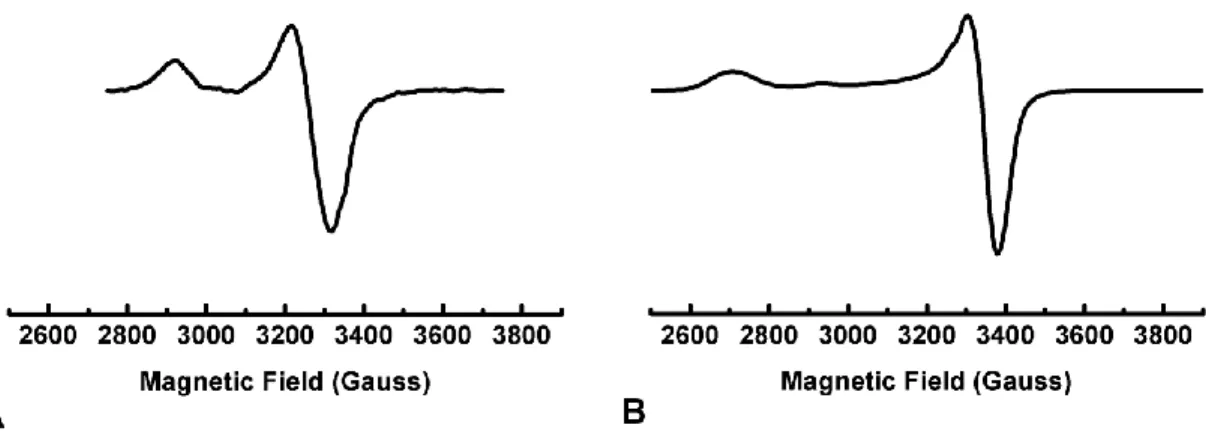
Conclusions
Furthermore, the intermediate generated by addition of acid to 4.1 is likely present in the catalytic mixture. Although the original hydrazido(2-) species were some of the first species identified by the protonation of N2 on Mo and W, 6.1 represents the first example of such a species on Fe and probably also the first example of a species on its way to NH3 formation. This still leaves the mechanism of further steps in the catalytic cycle open to debate.
Experimental Section
- General Considerations
- EPR Spectroscopy
- ENDOR Spectroscopy
- XAS Measurements
- Computational Methods
- Synthesis
This frozen tube solution was then removed from the glove box and subjected to EPR analysis. The solution of 4.1 was then dispensed into the ENDOR tubes using a syringe. The solutions were then thawed briefly and the HBArF4 · 2 Et2O solution was layered over the solutions of 4.1 in ENDOR tubes.
Supplementary Data for Chapter 2
Supplementary Data for Chapter 3
Supplementary Data for Chapter 4
Supplementary Data for Chapter 5
Supplementary Data for Chapter 6
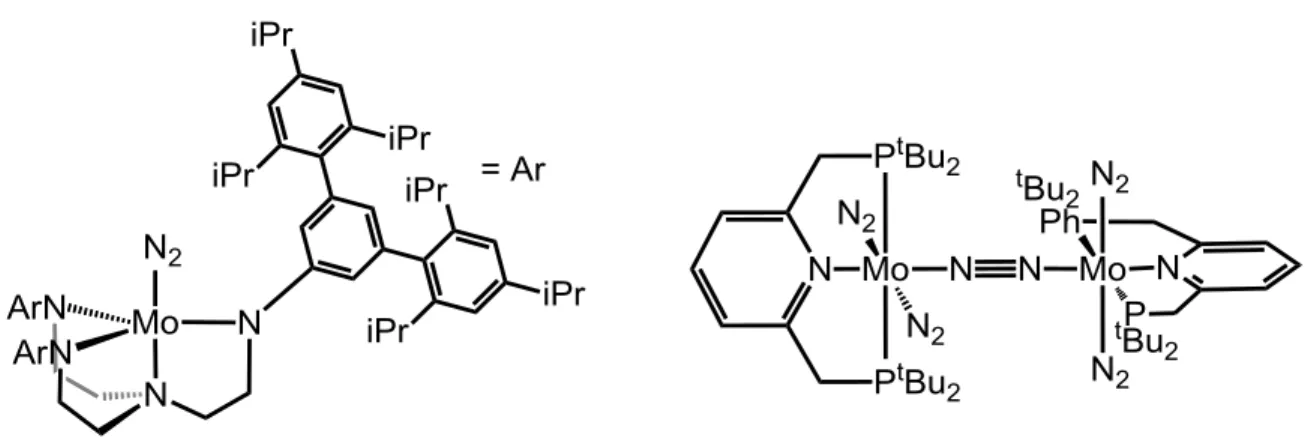
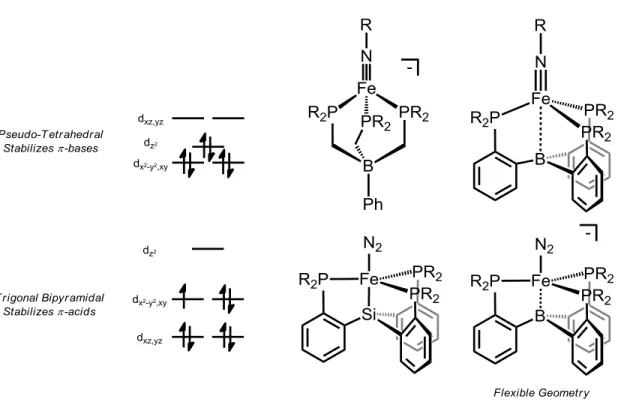
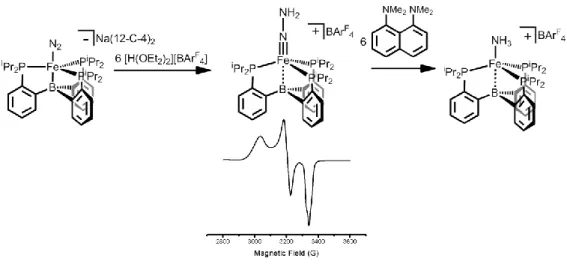
![Figure 2.1. CV of 2.1. Conditions: 100 mV/s THF, 0.01 M [NBu 4 ][PF 6 ], THF, glassy carbon working, Pt auxiliary, Ag/[Ag][NO 3 ] reference](https://thumb-ap.123doks.com/thumbv2/123dok/10413800.0/51.918.299.660.630.943/figure-conditions-thf-glassy-carbon-working-auxiliary-reference.webp)
